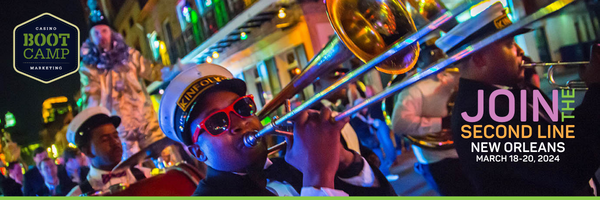As we planned this year’s Casino Marketing Boot Camp, the notion of engagement was ever-present and became the unofficial theme of this year’s discussions. As a brand marketer, I see the importance of engagement. In a conversation with Engaged Nation’s Jerry Epstein, he talked about the concept of “continuous engagement.” That made me stop and think.
We often try every trick in the book to engage customers. We measure engagements by the number of likes our social posts get. We measure engagement with the results of guest satisfaction surveys.
Moreover, if you read any of the marketing pundits, they will tell you engagement is THE goal. You can achieve the elusive engagement by following some easy 300-step formulas and investing in the latest tools. We’re often left with a ton of ideas with little understanding of how to put them into play (or worse, knowing if we even should).
Engagement has to be more than a thumbs up or star. What happens next? How do we maintain a cycle of engagement so that it is continuous? How do we engage with our customers and related audiences in a manner that always keeps our brand top of mind, always and continuously? Engagement, in and of itself, will always be a great goal, but continuous customer engagement is the next level.
As you can well imagine, there is a wide range of definitions for the term “customer engagement.” The common elements seem to be about the interactions your customers have with your brand. If you look at it in terms of interactions, you can see there are a multitude of ways to engage – and disengage – in a continuous fashion. Continuous engagement is a system of interpreting and evolving a comprehensive understanding of customers to engage them more productively at any point (perhaps all points) of their journey.
Some customers will choose to engage once, and if they find that interaction less than optimal, they will move on. Our core customers choose to engage over a series of interactions. For many of us, direct mail is the tool of choice to create continuous engagement. I want us to use all of the tools at our disposal to create a cycle of continuous engagement with all of our customers.
So why does the notion of engagement matter?
There was a time when acquiring customers was one of the most important in our casino marketing plans. Mature markets have lessened the impact of new member programs. We can all agree that acquisition will not be enough to grow our businesses in any sustainable fashion.
We know retention and potentially carving out a larger share of a customer’s wallet is the key. Both must be done in a budget-efficient manner to bring more of their spending to the bottom line.
Identifying avenues to create a connection with customers between visits can help us achieve those goals and grow in a sustainable fashion. Customer visits will not be wholly dependent on a reinvestment amount but rather a reinvestment of effort.
Customer relationship management is nothing without customer experience; in turn, customer experience cannot exist without some level of customer engagement. Moreover, as customers have these positive moments, they are more likely to become loyal and possibly brand advocates.
From loyalty come profits. According to Hall and Partners’ “Engager” study, up to 66% of a company’s profits rely on effective customer engagement. Companies that improve engagement increase their cross-sell and upsell revenue.
Some may mistakenly lump customer engagement and experience notions into one proverbial bucket, thinking them the same. They are not. Customer engagement is rather the result of a great experience.
How can we keep customers continuously engaged?
We are all familiar with the traditional “push” model of marketing. We sit on our couches and are rudely interrupted in our binging with a commercial. Push.
We open an app and see a pop-up ad at the top of the screen. Push.
On a drive to the grocery store, we see billboard after billboard after bus wrap. Push. Push. Push.
Engagement marketing instead pulls people in. By telling stories that interest consumers and creating conversations addressing their interests, brands and consumers are bonded into deeper relationships.
“If you only talk to customers about what you sell them, they have the option of tuning out,” says Mohan Sawhney, clinical professor of marketing and McCormick Foundation Chair of Technology at the Kellogg School. “The motto for engagement marketing is, ‘Ask not how you can sell, but how you can help.’”
The rise of social media
The growth of social media and its importance, not only in our marketing efforts but also in our customers’ lives, has been stunning. Can you think of any other media outlet that has come on the scene and overtaken the number one spot for attention in so quick a time? Social media has become an essential element in any marketer’s toolbox. Even in light of its constant metamorphosis, social media is not to be ignored. Today’s consumer expects to have a connection with their favorite brands. Some may say the connection may be what makes the brand a favorite.
Prioritize connections over conversions
The notion of conversations goes beyond a popular Facebook post. To successfully engage with customers, we must prioritize connections over conversions. This doesn’t mean that direct mail is less important. I think we can all agree; reinvestment is what makes our efforts successful, but I have often wondered if we were missing opportunities in this tool to create a long-term connection that can overrule the number on the coupon or the restrictions we impose on offers and rewards.
Small changes like personalization signal “We know you.” This appeals to the most basic human element in all of us – the desire to be seen.
Furthermore, we have access to large amounts of data points we can use to create near-personalized experiences for a large swath of customers.
The inside scoop
Casino customers love to know they have access or knowledge of the inside scoop. If they didn’t, we would never consider four-plus tiers or “secret tiers” to our player’s club programs.
Events like slot pulls that offer key customers the first chance to hit the jackpot on a new machine are simple and easy ways to add additional opportunities for engagement. Because these go beyond special lines or having your car left “up top” in valet, these moments can create a level of emotional connection akin to family memories.
You know me
In one of my first jobs with Harrah’s Entertainment (now Caesars Entertainment), we were trained on the five key elements our target avid experience player customers wanted. On that list was that they wanted to know that we knew and understood them. Truthfully, this wasn’t earth-shattering because, as consumers, don’t we all want this?
A transactional connection turned personal connection then further evolved into an emotional connection will always win the day. Always remember to introduce yourself. Be interested in them by asking questions. Remember dates and events that are important to them, not just because we have a standard mail program that sends them a card or email but also because we know them and have a connection.
Create a dialog
Dialog is one of the most valued elements in an engagement strategy. Allowing customers to weigh in on changes or additions and even providing an avenue for them to socialize and talk amongst themselves can increase and maintain a high level of engagement. When Nike shifted its “bringing out the athlete in you” focus from traditional advertising to personalized customer service, they created online communities that allowed customers to access and share workout advice. The Nike+ platform made it easier for customers to track and share their fitness goals. Additionally, we must adopt an “always-on” mentality for these communities. This may require rethinking staffing and assignments or investment in technology. The benefit of this approach is that we’re able to head off impending PR disasters that can go from incident to viral in mere seconds.
Solve for pain points
All of these aforementioned steps can provide the insight we need to solve for pain points. Without those steps, we can find our time wasted curing symptoms because we may not understand the actual problem.
Home-grown brand ambassadors
We have always recognized team members as brand ambassadors. They are the front-line faces that greet customers every day and help them navigate our operations for a great experience.
As influencer marketing is becoming an essential part of our marketing, many operators recognize the increased value of team members as influencers themselves. Still, to grow these influencers, we must ensure they are equally (if perhaps not more so) engaged.
The goal is a work environment where team members not only do their work; they do so with passion. Having that kind of focus on the back of the house can drive results.
We have probably all experienced companies we’ve worked with strive to achieve “employee engagement.” They might use surveys (among an assortment of tools) to gauge engagement, using those results to inform their next steps. Unfortunately, most tools used tend to be flawed as respondents believe (right or wrong) answers will be used to impact their advancement or role. As a result, answers can be skewed to what they may think management would like to hear.
Much like the customer continuous engagement model, a similar application for the back of the house can stimulate interest, creativity, motivation, and dedication.
Continuous Engagement Traits
Companies that practice continuous customer engagement generally exhibit some common traits.
- They eliminate barriers and break down the silos that will block how to holistically best serve the customer.
- They take the term “omnichannel” seriously. More than a marketing term, they create systems that, with the benefit of contextual customer insight and decisions, allow them to listen and interact with customers.
- More importantly, they are authentic in their customer focus. They understand that a win-win situation is good for all.
- Finally, they live with a clear set of values, and those values infuse the entire operation.
Ultimately the best way to ensure continuous engagement is to be true to the purpose we have as casino operators – to provide entertainment, whether online or in-person, and to always show our brand personalities in our communications.
This originally appeared in GGB Magazine.



Recent Comments